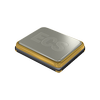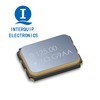Help with Oscillators specifications:
General Specifications
Back to Top
|
|
| ||
| Oscillator Type | |||
| Your choices are... | |||
| XO | Crystal oscillators (XOs) are non-compensated oscillators in which the resonant element is a crystal. They do not use correction or control to reduce frequency variations over temperature. | ||
| VCO | Voltage-controlled oscillators (VCOs). | ||
| VCXO | Voltage-controlled crystal oscillators (VCXOs) are crystal oscillators in which the frequency changes in direct proportion to the application of a control (tuning) voltage. | ||
| TCXO | Temperature-compensated crystal oscillators (TCXOs) are oscillators that use a thermistor network to generate a correction voltage to reduce the frequency deviations over temperature. The compensation network senses the ambient temperature and "pulls" the crystal frequency in order to reduce the frequency vs. temperature effect of the quartz crystal. | ||
| VCTCXO | Voltage-controlled, temperature-compensated, crystal oscillators (VCTCXOs) are also known as temperature compensated, voltage controlled, crystal oscillators (TCVCXOs). | ||
| OCXO | Oven-controlled crystal oscillators (OCXOs) use temperature control circuitry to hold the crystal and critical circuitry at a precise, constant temperature. They typically consist of a precision quartz crystal and oven block, temperature sensor, heating element, oven circuitry, and oscillator circuitry and insulating material. The crystal and its elements are placed in the oven block to maintain a stable temperature. | ||
| RbXO | Rubidium crystal oscillators (RbXOs). | ||
| VCSO | Voltage-controlled SAW oscillators (VCSO). | ||
| DRO | Dielectric resonator oscillators (DRO). | ||
| SPXO | Simple packaged crystal oscillators (SPXO). | ||
| Other | Other unlisted types of oscillators such as Gunn oscillators, Hartley oscillators, Yig oscillators, etc. | ||
| Search Logic: | All products with ANY of the selected attributes will be returned as matches. Leaving all boxes unchecked will not limit the search criteria for this question; products with all attribute options will be returned as matches. | ||
| Package / Form Factor | |||
| Your choices are... | |||
| Surface Mount Technology (SMT) | Surface mount technology (SMT) adds components to a printed circuit board (PCB) by soldering component leads or terminals to the top surface of the board. SMT components have a flat surface that is soldered to a flat pad on the face of the PCB. Typically, the PCB pad is coated with a paste-like formulation of solder and flux. With careful placement, SMT components on solder paste remain in position until elevated temperatures, usually from an infrared oven, melt the paste and solder the component leads to the PCB pads. Industry-standard pick-and-place equipment can mount SMT components quickly, accurately, and cost-effectively. SMT is a widely used alternative to mounting processes that insert pins or terminals through holes and solder leads into place on the opposite side of the board. | ||
| Through Hole Technology (THT) | Through hole technology (THT) mounts components on a printed circuit board (PCB) by inserting component leads through holes in the board and then soldering the leads in place on the opposite side of the board. | ||
| Connectorized | Connectorized devices attach with coaxial or other types of connectors. | ||
| Waveguide Assembly | Waveguide assemblies are used in microwave waveguide systems. They consist of a hollow metallic conductor with a rectangular, elliptical, or circular cross-section. Some conductors contain solid or gaseous dielectric materials. | ||
| Module / Board | Devices are modules or boards. | ||
| Other | Other unspecified packages. | ||
| Search Logic: | All products with ANY of the selected attributes will be returned as matches. Leaving all boxes unchecked will not limit the search criteria for this question; products with all attribute options will be returned as matches. | ||
| RF Connector: | |||
| Your choices are... | |||
| BNC | Bayonet Neil-Concelman (BNC) connectors were designed for military applications, but are used widely in video and RF applications to 2 GHz. BNC connectors have a slotted outer conductor and a plastic dielectric that causes increasing losses at higher frequencies. BNC connectors are usable above 4 GHz as long as the slots radiate signals; however, these devices may not be mechanically stable to 10 GHz. Both 50Ω and 75Ω BNC connectors are available. BNC connectors are also known as bayonet navy connectors or baby Neil connectors. | ||
| SMA | Subminiature-A (SMA) connectors are intended for use on semi-rigid cables in components. They directly interface the cable dielectric without air gaps. They are not intended for permanent connections. | ||
| SMB | Subminiature-N (SMB) connectors are snap-mount connectors that are available either in 50Ω or 75Ω impedances. They are used for frequencies from DC to 4GHz. | ||
| SMP | Subminiature-P (SMP) connectors are rated to 40 GHz and, depending on detent type, can withstand from 100 to 1,000 interconnect cycles. | ||
| TNC | Threaded Neil-Concelman (TNC) connectors are similar in size to BNC connectors but feature a threaded coupling nut for applications that require performance to 11 GHz. TNC connectors are durable, reliable devices that are widely used in the cellular and mobile communication industry for equipment cabling and antenna interfaces. | ||
| Other | Other unlisted connectors. | ||
| Search Logic: | Products with the selected attribute will be returned as matches. Leaving or selecting "No Preference" will not limit the search criteria for this question; products with all attribute options will be returned as matches. | ||
| Features / Standards | |||
| Your choices are... | |||
| RoHS Compliant | Restriction of Hazardous Substances (RoHS) is a European Union (EU) directive that requires all manufacturers of electronic and electrical equipment sold in Europe to demonstrate that their products contain only minimal levels of the following hazardous substances: lead, mercury, cadmium, hexavalent chromium, polybrominated, biphenyl and polybrominated diphenyl ether. RoHS will become effective on July 1, 2006. | ||
| Lead Free | Devices do not contain lead (Pb) in any form. The electronics industry is working to provide lead-free products in response to concerns about the environmental impact of using lead in solder finishes. These efforts are in response to both customer demands and government directives to decrease the amount of waste from consumer electronics. Officially, products that are lead free have less than 1000 ppm lead by weight. | ||
| Programmable | The frequency of the device can be selected and programmed by the user. | ||
| Military Standard | The device is suited for military applications. | ||
| WEEE Compliant | The Waste Electrical and Electronics Equipment Regulations (WEEE Regulations) is a European Parliament Directive with the aim of encouraging reuse, recycling, and recovery of electrical and electronic equipment, and to improve the environmental impact and performance of these equipments. This directive sets the requirements and criteria for the collection, treatment, recycling, and recovery of these equipments. It makes producers responsible for financing these activities, and retailers and distributors must provide means for consumers to return used or obsolete equipments without charge. | ||
| Search Logic: | All products with ANY of the selected attributes will be returned as matches. Leaving all boxes unchecked will not limit the search criteria for this question; products with all attribute options will be returned as matches. | ||
Performance
Back to Top
|
|
| ||
| Oscillation Frequency | This is the nominal value of the oscillator frequency. | ||
| Search Logic: | User may specify either, both, or neither of the "At Least" and "No More Than" values. Products returned as matches will meet all specified criteria. | ||
| Total Frequency Stability | Total frequency stability is the maximum frequency deviation from the nominal value for all conditions (e.g., temperature, supply voltage, etc.). It is usually measured in parts per million (ppm). | ||
| Search Logic: | All matching products will have a value less than or equal to the specified value. | ||
| Frequency Tolerance | Frequency tolerance or frequency error is the allowed, stated deviation of the nominal oscillation frequency. Generally, this amount is expressed as a percentage (%). | ||
| Search Logic: | All matching products will have a value less than or equal to the specified value. | ||
| Phase Noise (@ 10kHz) | Phase noise is the short term random fluctuations of the phase of a signal. Phase noise is particularly important in oscillators because this value is directly related to the frequency stability of the output signal. Phase noise is measured (in dBc/Hz) at different offset frequencies from the carrier frequency. Typically, phase noise is measured at offset frequencies of 1 kHz or 10 kHz, from the carrier frequency. | ||
| Search Logic: | User may specify either, both, or neither of the "At Least" and "No More Than" values. Products returned as matches will meet all specified criteria. | ||
| Output Power | Output power is the total signal power produced by the device. | ||
| Search Logic: | User may specify either, both, or neither of the "At Least" and "No More Than" values. Products returned as matches will meet all specified criteria. | ||
| Tuning Voltage | The tuning voltage is an input dc voltage used to adjust the oscillator frequency, or to compensate for long-term frequency drifts due to aging or other factors. | ||
| Search Logic: | User may specify either, both, or neither of the "At Least" and "No More Than" values. Products returned as matches will meet all specified criteria. | ||
| Harmonic Suppression | Harmonic suppression is the capability of the oscillator to mitigate the power of a harmonic of the output signal. Harmonics are signal components whose frequencies are integer multiple of the fundamental frequency. The most important harmonics for typical oscillators is the second harmonic. In general, a good oscillator will greatly mitigate the power of the second harmonic. Harmonic suppression is measured in terms of decibels relative to the power of the carrier (dBc), which is the decibel value of the ration of the harmonic power to the carrier power. | ||
| Search Logic: | User may specify either, both, or neither of the "At Least" and "No More Than" values. Products returned as matches will meet all specified criteria. | ||
| Operating Temperature | This is the full-required range of ambient operating temperatures. | ||
| Search Logic: | User may specify either, both, or neither of the limits in a "From - To" range; when both are specified, matching products will cover entire range. Products returned as matches will meet all specified criteria. | ||
| Supply Voltage: | This is the typical operating voltage of the oscillator (Vcc). | ||
| Your choices are... | |||
| 1.8 V | The typical operating voltage is 1.8 V. | ||
| 2.5 V | The typical operating voltage is 2.5 V. | ||
| 3.3 V | The typical operating voltage is 3.3 V. | ||
| 5.0 V | The typical operating voltage is 5.0 V. | ||
| 12.0 V | The typical operating voltage is 12 V. | ||
| 15 V | The typical operating voltage is 15 V. | ||
| Other | Other unlisted operating voltages. | ||
| Search Logic: | All products with ANY of the selected attributes will be returned as matches. Leaving all boxes unchecked will not limit the search criteria for this question; products with all attribute options will be returned as matches. | ||
| Output Type: | |||
| Your choices are... | |||
| TTL | Transistor-transistor logic (TTL) is a class of digital circuits built from bipolar junction transistors (BJT), diodes and resistors. All TTL circuits operate with a 5 V power supply. TTL signals are defined as "low" or L when between 0 V and 0.8 V with respect to the ground terminal, and "high" or H when between 2 V and 5 V. | ||
| CMOS | Complementary metal-oxide semiconductor (CMOS) is a low-power technology that can achieve high switching speeds. The voltage swing is 0 V to supply voltage. | ||
| HCMOS | High-speed CMOS (HCMOS) provides faster switching speeds than conventional CMOS. The voltage swing is 0 V to supply voltage. | ||
| ECL | Emitter coupled logic (ECL) is an extremely high-speed logic that consumes a great amount of power. ECL has a very small voltage swing, typically 0.8 V to -0.8 V). | ||
| PECL | Positive emitter coupled logic (PECL). | ||
| LVPECL | Low voltage positive emitter coupled logic (LVPECL). | ||
| LVDS | Low voltage differential signaling (LVDS). | ||
| Sine Wave | The output is a sinusoidal wave. | ||
| Other | Other types of logic output such as current mode logic (CML), etc. | ||
| Search Logic: | All products with ANY of the selected attributes will be returned as matches. Leaving all boxes unchecked will not limit the search criteria for this question; products with all attribute options will be returned as matches. | ||


